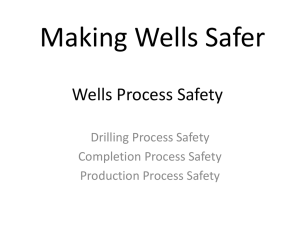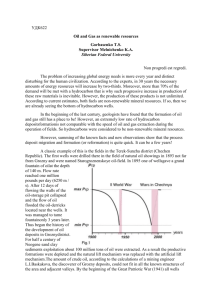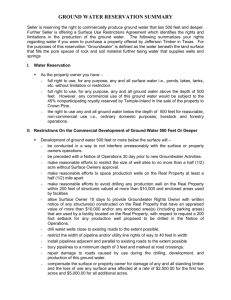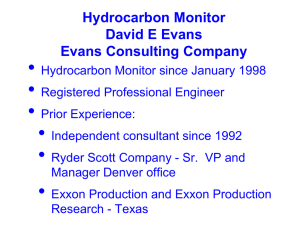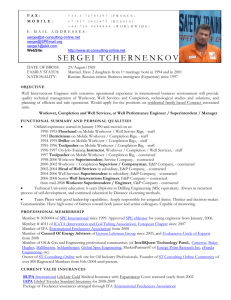Valiyev speech ENG
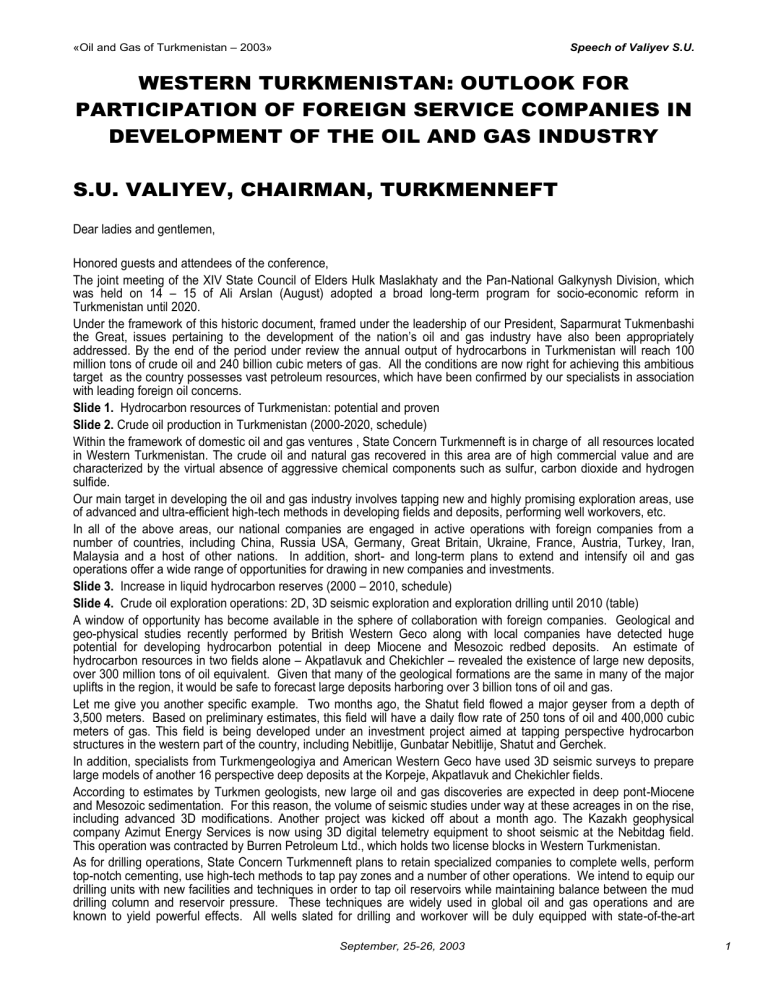
«Oil and Gas of Turkmenistan – 2003»
Speech of Valiyev S.U.
WESTERN TURKMENISTAN: OUTLOOK FOR
PARTICIPATION OF FOREIGN SERVICE COMPANIES IN
DEVELOPMENT OF THE OIL AND GAS INDUSTRY
S.U. VALIYEV, CHAIRMAN, TURKMENNEFT
Dear ladies and gentlemen,
Honored guests and attendees of the conference,
The joint meeting of the XIV State Council of Elders Hulk Maslakhaty and the Pan-National Galkynysh Division, which was held on 14 – 15 of Ali Arslan (August) adopted a broad long-term program for socio-economic reform in
Turkmenistan until 2020.
Under the framework of this historic document, framed under the leadership of our President, Saparmurat Tukmenbashi the Great, issues pertaining to the development of the nation’s oil and gas industry have also been appropriately addressed. By the end of the period under review the annual output of hydrocarbons in Turkmenistan will reach 100 million tons of crude oil and 240 billion cubic meters of gas. All the conditions are now right for achieving this ambitious target as the country possesses vast petroleum resources, which have been confirmed by our specialists in association with leading foreign oil concerns.
Slide 1. Hydrocarbon resources of Turkmenistan: potential and proven
Slide 2. Crude oil production in Turkmenistan (2000-2020, schedule)
Within the framework of domestic oil and gas ventures , State Concern Turkmenneft is in charge of all resources located in Western Turkmenistan. The crude oil and natural gas recovered in this area are of high commercial value and are characterized by the virtual absence of aggressive chemical components such as sulfur, carbon dioxide and hydrogen sulfide.
Our main target in developing the oil and gas industry involves tapping new and highly promising exploration areas, use of advanced and ultra-efficient high-tech methods in developing fields and deposits, performing well workovers, etc.
In all of the above areas, our national companies are engaged in active operations with foreign companies from a number of countries, including China, Russia USA, Germany, Great Britain, Ukraine, France, Austria, Turkey, Iran,
Malaysia and a host of other nations. In addition, short- and long-term plans to extend and intensify oil and gas operations offer a wide range of opportunities for drawing in new companies and investments.
Slide 3. Increase in liquid hydrocarbon reserves (2000 – 2010, schedule)
Slide 4. Crude oil exploration operations: 2D, 3D seismic exploration and exploration drilling until 2010 (table)
A window of opportunity has become available in the sphere of collaboration with foreign companies. Geological and geo-physical studies recently performed by British Western Geco along with local companies have detected huge potential for developing hydrocarbon potential in deep Miocene and Mesozoic redbed deposits. An estimate of hydrocarbon resources in two fields alone – Akpatlavuk and Chekichler – revealed the existence of large new deposits, over 300 million tons of oil equivalent. Given that many of the geological formations are the same in many of the major uplifts in the region, it would be safe to forecast large deposits harboring over 3 billion tons of oil and gas.
Let me give you another specific example. Two months ago, the Shatut field flowed a major geyser from a depth of
3,500 meters. Based on preliminary estimates, this field will have a daily flow rate of 250 tons of oil and 400,000 cubic meters of gas. This field is being developed under an investment project aimed at tapping perspective hydrocarbon structures in the western part of the country, including Nebitlije, Gunbatar Nebitlije, Shatut and Gerchek.
In addition, specialists from Turkmengeologiya and American Western Geco have used 3D seismic surveys to prepare large models of another 16 perspective deep deposits at the Korpeje, Akpatlavuk and Chekichler fields.
According to estimates by Turkmen geologists, new large oil and gas discoveries are expected in deep pont-Miocene and Mesozoic sedimentation. For this reason, the volume of seismic studies under way at these acreages in on the rise, including advanced 3D modifications. Another project was kicked off about a month ago. The Kazakh geophysical company Azimut Energy Services is now using 3D digital telemetry equipment to shoot seismic at the Nebitdag field.
This operation was contracted by Burren Petroleum Ltd., which holds two license blocks in Western Turkmenistan.
As for drilling operations, State Concern Turkmenneft plans to retain specialized companies to complete wells, perform top-notch cementing, use high-tech methods to tap pay zones and a number of other operations. We intend to equip our drilling units with new facilities and techniques in order to tap oil reservoirs while maintaining balance between the mud drilling column and reservoir pressure. These techniques are widely used in global oil and gas operations and are known to yield powerful effects. All wells slated for drilling and workover will be duly equipped with state-of-the-art
September, 25-26, 2003 1
«Oil and Gas of Turkmenistan – 2003»
Speech of Valiyev S.U. wellhead facilities made by leading global producers. For this purpose, we have already begun to collaborate with such companies as Vetco Gray, Cameron, Varco, etc.
Special attention is also being devoted to test operations performed with advanced drill bits, measuring equipment used win drilling without raising the drill string, drilling horizontal bore holes, applying new top-driven drilling systems used for destroying the down-hole environment with a large number of special high-pressure jet nozzles and many other new techniques. State Concern Turkmenneft is ready and willing to examine proposals from potential foreign partners.
Rational and highly efficient development of our fields is possible taking into account all of the specific features of their geological formation.
All fields in West Turkmenistan have multiple layer structure and are made of several dozens to several hundreds of individual reservoirs. Their large numbers and broad variety in terms of types, saturation and ratio between hydrocarbon liquids and gas, thermodynamic conditions, reservoir rock properties, fracturing, significant vertical variance of productivity and other features predetermine special approaches to designing and managing production from individual fields.
In most of the fields a portion of deposits are associated with low permeability and complexly structured sand-silstone reservoirs. There are oil deposits associated with narrow oil rims with vast gas caps. Development of spread reservoirs, which are widely spread, in particular, in the Gogerendal-Ekerem area in the south, requires meticulous study of specific conditions and application of modern technology and equipment. To achieve this, the concern has implemented a number of novelties in recent years.
The introduction of commingled production technology is having a favorable impact in terms of savings on drilling, improvement of current production and fast-track development of new reservoirs. Introduction of commingled production technology at the South Gamyshlyja and Korpeje fields which combines production from an oil horizon with a gas horizon has provided the capability to produce either oil or gas depending on seasonal demand. The commingled production schemes in use have been implemented by the workover unit with participation by Schlumberge using equipment developed by that company. The use of wireline tools and equipment and slickline technology in commingled production wells provides significant time savings.
The use of Schlumberger’s high-power PNK-86 and Enerjet perforators to complete low permeability formations with underbalanced peroration has had a favorable effect on improving well production rates. At the Goturdepe fields bottomhole strengthening technology developed by the China Petroleum Engineering and Construction Company is used in horizon A wells to prevent sand production, with the company participating in the introduction of the technology.
A number of new oil and gas deposits were discovered during the course of exploration drilling. A part of these deposits are associated with poorly consolidated formations and unstable reservoirs made up of sandstone and silstone. These reservoirs represent an additional significant opportunity for increasing oil and gas production. We will consider any new proposals to prevent sand production from producing wells.
During development drilling in difficult conditions of oil and gas saturation of the Lower Red Bed formations there has been a need to identify all producing reservoirs by using modern formation testing tools. This is of particular importance at fields in South-West Turkmenistan: South Gamyshlyja, Nebitlije, Akpatlavuk, Chekichler, Keimir, Shatut and others.
There are plans to drill 35 producing oil wells and up to 15 gas wells with depths of between 3,000 and 4,000 meters at the above fields in the near term (by 2005). The concern will be interested in cooperating with foreign companies in this area if economically viable terms are offered.
However, the main future of oil production is in the development of reservoirs located at depths of 5,000 to 7,000 meters.
By 2005, almost half of Turkmenistan’s oil and gas will be produced from deep formations. There are 12 Chinese-built rigs capable of drilling wells to depths of 5,000 to 7,000 meters, which have already been tested successfully at depths of up to 5,000 meters. Four wells are currently being drilled at western fields of Goturdepe, Akpatlavuk, Gundogar
Cheleken and Cheleken, with design depths between 5,200 and 6,500 meters. The drilling rig built by Bentec of
Germany is designed for drilling to significant depths. It was used to drill a 4,700 meter deep well at the East Cheleken field in 2002, which flowed oil.
In the area of oil and gas production, the particular structural features of oil and gas reservoirs, formation and formation fluid properties and their changes in the course of development require that a number of issues be addressed during well operation.
Gas lift production. The Turkmenneft state-owned concern has developed and implemented a high-pressure gas lift system which allows maximum depths of the gas injection point and increased differential pressure drawdown. For this purpose, modular compressor stations operating at 120 bar working pressure were built at the Goturdepe and Barsagelmez fields. It is absolutely critical to obtain data on the operating parameters of gas lift wells and be able to adjust the operating mode on a continuous basis using gas lift computer-based systems in order to optimize gas lift well operation.
Downhole pump production. Shut-in and producing fluid level and pump operating parameters in wells with downhole pumps are determined using echometering and load readings using autonomous computer-based dynamometers, which have demonstrated good performance.
September, 25-26, 2003 2
«Oil and Gas of Turkmenistan – 2003»
Speech of Valiyev S.U.
Bottom-hole treatment processes. There is interest in trying out bottom-hole treatment technology in producing wells. In addition, Turkmenneft is particularly interested in cooperation on the problem of water shutoff in oil and gas wells.
Gas treatment. The concern has an objective to make a sound selection of gas treatment methods, which would provide required qualitative parameters at advanced stages of field development at wellhead pressures insufficient to achieve cooling through the Joule-Thomson throttling effect. There is a future in using absorption technology. At the moment there is a need for a solution that can provide hydrocarbon liquefaction together with gas treatment.
Well workover. Well workover operations using a coiled tubing unit from Nis-Naftagas of Serbia started in
2003. Good performance was achieved, justifying wider use of such units in Turkmenneft’s well workover operations.
The concern is also willing to consider other proposals in the area of oil and gas production.
Slide 5. Volume of Investment in Oil Production in West Turkmenistan Until 2010 (table)
The overall requirements of the Turkmenneft government-owned concern for new equipment and technology until 2005 are estimated at US$120-150 million.
In conclusion, I would like to point out that cooperation with foreign partners is being carried out on mutually beneficial terms and is already yielding fine results in the development of hydrocarbon resources in West Turkmenistan.
Thank you for your attention.
Welcome to Turkmenistan.
September, 25-26, 2003 3

